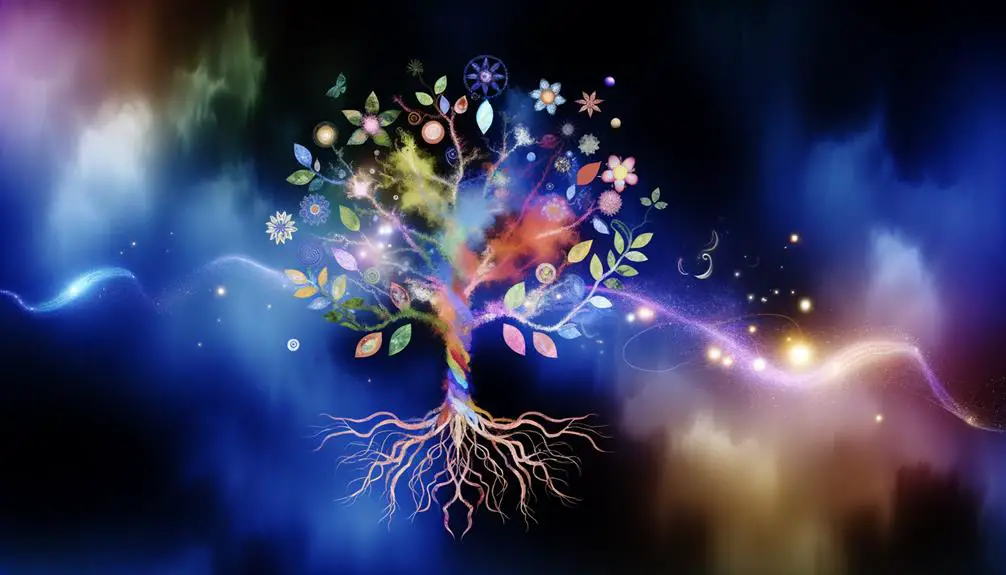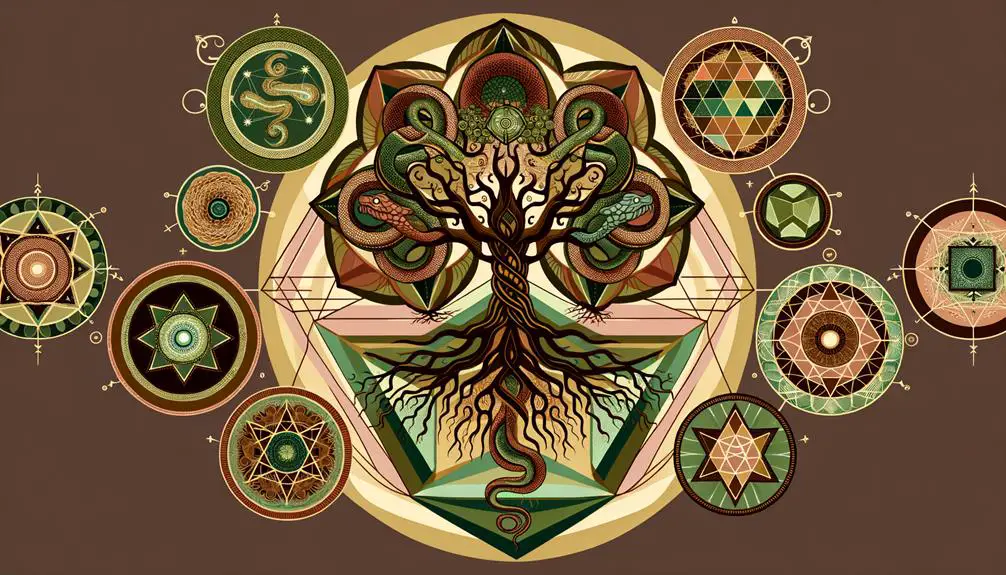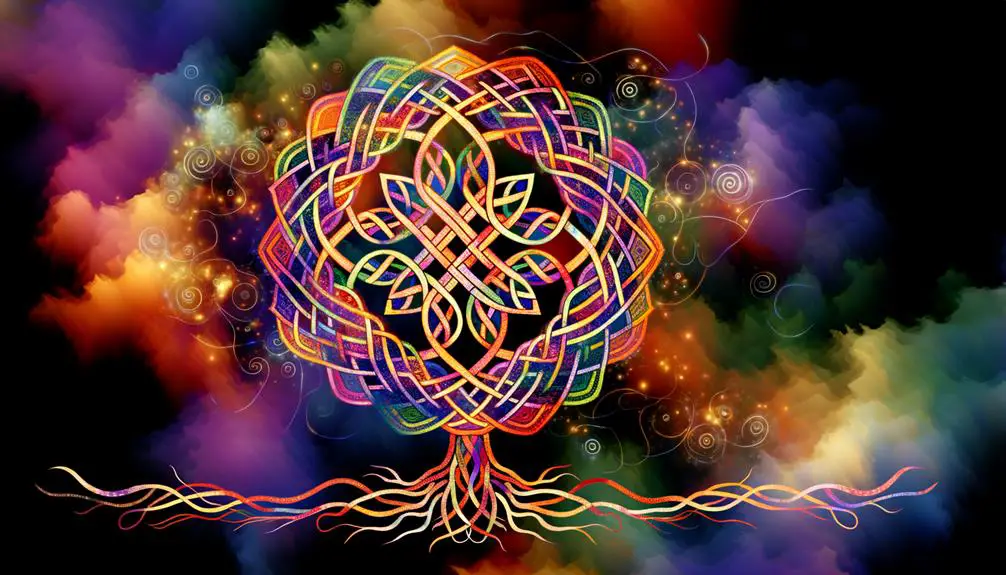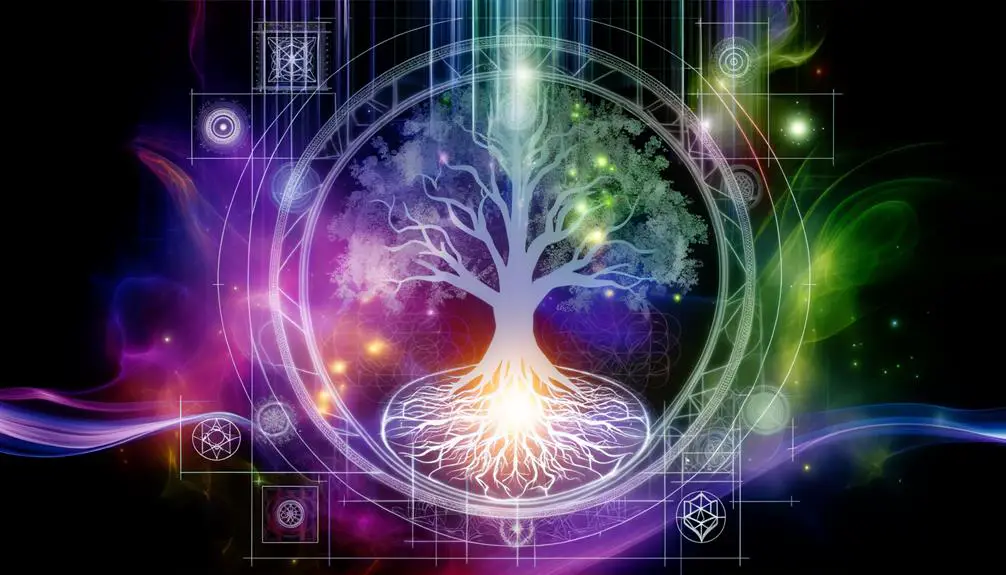What Is the Symbol of the Tree of Life and Its Meaning?
The symbol for the Tree of Life holds deep meaning across ancient mythologies, religious traditions, and cultural interpretations. It signifies interconnectedness, creation, and immortality.
In Mesopotamian culture, it symbolizes divine knowledge, while Norse mythology's Yggdrasil connects the heavens, earth, and underworld. Christianity views it as a representation of eternal life and divine providence, and Kabbalistic Judaism uses it to illustrate spiritual enlightenment.
In Celtic culture, it symbolizes harmony, and in Mesoamerican traditions, it acts as a bridge between worlds. Its depiction in art and modern spirituality further underscores its representation of unity, growth, and eternal existence.
Further exploration reveals its universal philosophical and spiritual significance.

Key Takeaways
- The Tree of Life symbolizes interconnectedness, creation, and immortality in various ancient mythologies.
- In Christianity, the Tree of Life represents eternal life and God's providence.
- The Kabbalistic Tree of Life illustrates the path to spiritual enlightenment in Judaism.
- In Celtic culture, the Tree of Life symbolizes harmony and balance.
- Modern spirituality views the Tree of Life as embodying personal and spiritual evolution, unity, and wholeness.
Ancient Mythologies

The concept of the Tree of Life is deeply ingrained in various ancient mythologies, serving as a symbol of interconnectedness, creation, and immortality across diverse cultures.
In Mesopotamian mythology, it represents divine knowledge and eternal life, often depicted in sacred texts and stone carvings.
The Norse Yggdrasil, a mighty ash tree, connects the heavens, earth, and underworld, embodying the universe's cyclical nature.
Similarly, in ancient Egyptian mythology, the Tree of Life symbolizes birth, death, and rebirth, linking to the gods' eternal existence.
These mythological representations underscore the Tree of Life's pivotal role in illustrating humanity's quest to comprehend existence, the cosmos, and the perpetual cycles of nature.
This universality underscores its enduring relevance in human thought.
Religious Significance
Building on its mythological roots, the Tree of Life holds profound religious significance in numerous spiritual traditions, symbolizing divine connection, wisdom, and the eternal nature of existence.
In Christianity, it appears in the Garden of Eden, representing eternal life and God's providence.
Kabbalistic Judaism views it as a diagram of the divine emanations, illustrating the path to spiritual enlightenment.
Hinduism identifies it with the sacred Ashvattha tree, symbolizing the interconnectedness of all life.
In Islam, the Sidrat al-Muntaha signifies the ultimate boundary in the heavens, beyond which no being can pass.
Each tradition, while distinct, utilizes the Tree of Life to convey themes of spirituality, interconnectedness, and the pursuit of transcendent wisdom, underscoring its universal religious relevance.
Cultural Interpretations

Across diverse cultures, the Tree of Life encapsulates a rich tapestry of meanings and symbols, reflecting the unique values, beliefs, and historical contexts of each society.
In Celtic culture, it symbolizes harmony and balance, illustrating the interconnectedness of life.
Ancient Egyptians viewed it as a representation of eternal life and divine wisdom.
In Mesoamerican traditions, the Tree of Life is often depicted as a source of sustenance and a bridge between worlds.
Chinese mythology associates it with immortality and cosmic order, signified by the sacred peach tree.
These varied interpretations demonstrate the Tree of Life's adaptability, embedding itself into the cultural fabric through myths, folklore, and philosophical ideologies, thereby serving as a universal emblem of life's continuity and unity.
Symbolism in Art
In art, the Tree of Life serves as a profound symbol, embodying themes of growth, connection, and eternity across various artistic traditions. Its representation varies widely, from intricate carvings in ancient temples to vibrant motifs in modern paintings.
The roots, trunk, and branches are often depicted to illustrate a continuum of life, connecting the earthly and the divine. Artists employ this symbol to explore the interconnectedness of all living beings and the cyclical nature of existence.
In many cultures, it evokes a sense of balance and harmony, a visual attestation to the unity of life's various stages. This enduring symbol transcends cultural boundaries, offering a universal language through which complex philosophical and spiritual ideas can be communicated.
Modern Spirituality

As contemporary society increasingly seeks meaning beyond traditional religious frameworks, the Tree of Life has emerged as a potent symbol in modern spirituality, embodying holistic principles and personal growth. This symbol resonates with individuals looking for interconnectedness and universal truths. The Tree of Life's roots, trunk, and branches illustrate a journey from groundedness to spiritual enlightenment.
Key aspects of its significance in modern spirituality include:
- Interconnectedness: Represents the unity of all life forms.
- Growth and Development: Symbolizes personal and spiritual evolution.
- Balance: Reflects harmony between physical and spiritual domains.
- Resilience: Demonstrates strength and endurance through challenges.
- Wholeness: Embodies completeness and integration of various life aspects.
This rich symbolism offers a multifaceted approach to understanding and exploring contemporary spiritual landscapes.
Conclusion
The symbol of the Tree of Life transcends ancient mythologies, religious doctrines, and cultural interpretations, embodying a profound interconnectedness of existence.
In artistic representations, it stands as an unparalleled proof of human creativity and spiritual aspiration.
Modern spirituality continues to draw from its inexhaustible well of symbolism, making it a timeless emblem of growth, unity, and eternal life.
The Tree of Life, as a result, remains an indomitable icon, bridging the past and present in an extraordinary continuum of meaning.






